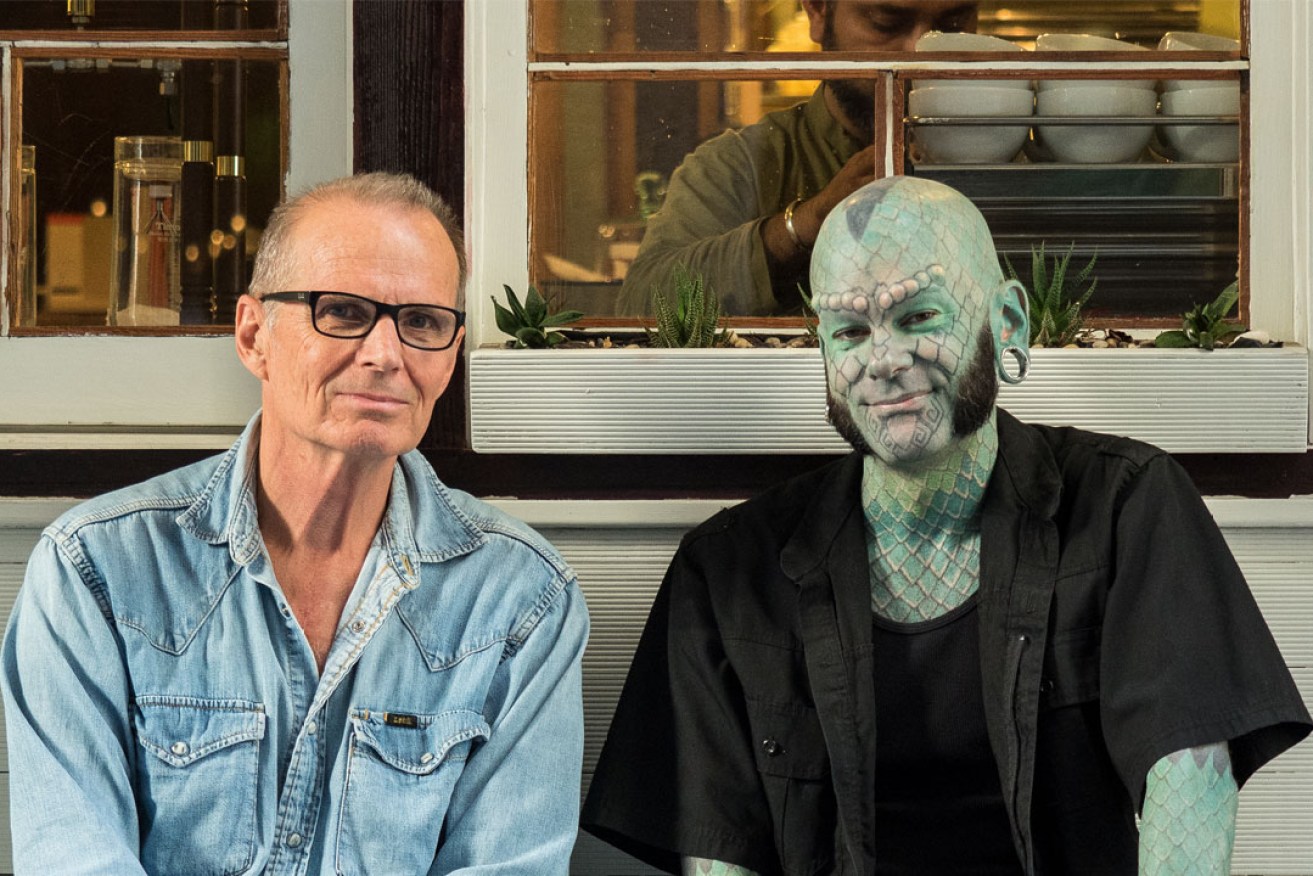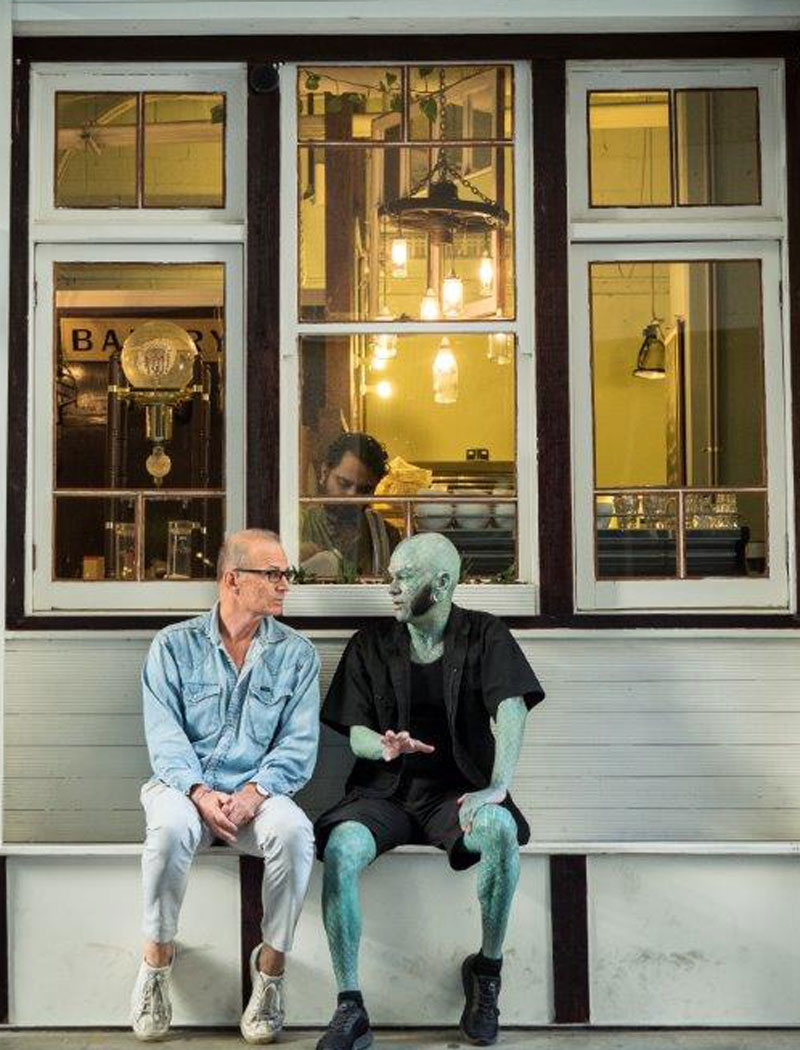Lizards, art and philosophy
It’s said that a tattoo is only as good as the reason for having it – but why would anyone want to cover themselves head-to-toe in reptilian scales? Rainer Jozeps sat down for a chai with Lizardman to find out.


Rainer Jozeps with the performance artist known as Lizardman. Photo: Sam Jozeps
Recently, I’ve come to know sideshow and performance artist Erik Sprague, aka the Lizardman. He’s probably the most famous performance artist in the world today, with green ink and lizard scales tattooed over his entire body, among other surgical modifications.
The Lizardman has appeared on all the daytime and morning TV shows across America, he’s emceed worldwide tours for bands like Slayer and Slipknot, his live act is featured in festivals throughout the US, Britain and Europe, and he even does corporate shows.
He loves Australia – especially Adelaide; this is his eighth Adelaide Fringe.
And he’s very, very successful.
A quick Google search reveals countless images of a man with unhuman-like features that must surely be applied by make-up. But no.
Reptilian scales are tattooed over every part of his light frame, including his face; there are 10 lumps of cartilage implanted above his left and right brows; his tongue is surgically split in two (a procedure subsequently banned by US surgeons), and most of his upper teeth have been filed into points. He has varying shades of green ink tattooed over his entire body, head to toe, including his eyelids and eye sockets – and it’s all permanent. He looks frightening.

Photo: Sam Jozeps
Why? What on earth would motivate someone to do this to themselves? What if he woke up one day and realised the severity of the mistake he’d made? A life ahead of torturous consequence and regret? What will he look like, and how will he feel about his choices, when he’s an old man?
The Lizardman comes from a rich tradition of all-body tattoo performers, from George (Captain) Costentenus, who appeared with PT Barnum in the 1870s, through to Horace Ridler (The Great Omi), 1892-1969.
From Victorian times to the mid-20th century, “freak show” performers, many with physical abnormalities, appeared with tattoo-adorned sword swallowers or fire-eaters in “ten-and-one” shows across America, England, Australia and Europe (10 so-called “freaks” for one able-bodied, skilled performer).
Remnants of these could be seen up to the early 1960s in the sideshow alleys of Australia’s royal agricultural shows.
I wanted to investigate the Lizardman phenomenon, so I arranged to meet him for coffee. I prepped the café owner in case his guests might run out of the premises, screaming as if in a B-grade horror movie.
Turns out this reptile prefers chai, the proprietor was thrilled to have him, and a cheerful buzz rose among the clientele when Erik entered. I quickly learned that people, young and old, love the Lizardman.
And there was more for me to learn.
“Every day I have to go out and justify myself to a stranger, but when they sit down and talk to me, they learn what’s underneath all this… you have to find happiness in what you can have… if (you think) what makes you happy is unattainable, then congratulations, you’ve doomed yourself to failure.”
It didn’t take long for the tattoos, implants, split tongue and sharpened teeth to lose their grotesque novelty. As we chatted, I came to see the man within rather than the cartoon figure without.
I listened, I looked into his eyes, and while it seemed he was appearing to me from behind a mask, I know that we all wear masks of one kind or another. Some feel naked without make-up, others avert eye contact for fear of revealing themselves.
In challenging people, I’m causing people to look at themselves as much as me
Erik’s tattooing began in 1994 and is still going. He has a degree in art and philosophy, and a yet-to-be completed PhD dissertation defence. At 48 years old, he’s married, lives in Austin, Texas, and performs all over the world, 300 days a year.
Does he scare children in public places?
“No, but if they did get frightened it would say more about how they were parented,” he says politely.
His goal is to be known as an icon of the tent show genre; a genre that might well be flickering back into life. One can argue the toss on the aspiration, or question whether artistry is evident at all in the whole Lizardman project.
But what can’t be argued with is that Erik Sprague shocks and challenges us. His uncompromising preparedness to create and portray a character that both fascinates and beguiles is the art of his creation.
“The only thing better than creating something is being that creation,” he says, sipping on his chai.
“I hold the Platonian view that an unexamined life is a life not worth living. In challenging people, I’m causing people to look at themselves as much as me.”
And why a Lizard?
Wrestling with concepts like identity through references to occultist Aleister Crowley, Socrates and philosopher Ludwig Wittgenstein, he finally arrives at an answer I understand.
“I think I look incredibly cool; when I look in the mirror I smile.”
Lizardman is performing in the (non-ticketed) Déjà Voodoo sideshow in the Garden of Unearthly Delights from 7pm-late week nights and 4pm-late on weekends throughout the Adelaide Fringe.
Rainer Jozeps has been an executive in Australia’s arts industry for more 30 years. He has held senior roles with the Australian Elizabethan Theatre Trust, Adelaide Festival Centre, West Australian Ballet, Australian Dance Theatre and Adelaide Symphony Orchestra.




